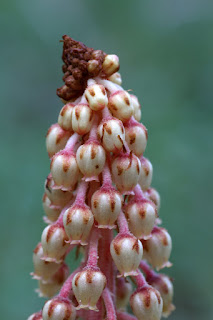For lack of anything else to publish, I thought I would post some pictures of the different saprophytic plants we've encountered in our rambles. Actually, these are not considered saprophytic anymore and even the term is obsolete. They are instead now referred to as mycotrophic.
The older term, "saprophytic," meant that these plants fed off decaying plant material in the soil. While that is not entirely untrue, the fact is that they get their nutrients through a symbiotic (mutual) relationship with a soil fungus named mycrorrhiza and not directly from the soil.
In ordinary terms, these plants are usually leafless and without chlorophyll. In our area they include a number of orchids, the Coralroots, of which Washington has five, as well as various other odd and unusual plants, the Vancouver Groundcones, Pinedrops and Candysticks.
The Coralroots are a group of orchids usually found in heavily forested and rather shady and dry areas. Several of them have quite insignificant flowers, but some of them are very beautiful. A couple are quite rare but some are very common and can easily be found.
Ozette and Spotted Coralroots
Western Coralroot
Striped Coralroot
Early Coralroot
The only other mycotrophic orchid in the state of Washington is the most beautiful of them all, the Phantom Orchid, Cephalanthera austiniae, named for its bone white color and for the fact that it appears phantom-like on dark forest floors where nothing else seems to be growing.
Other mycotrophs, though not orchids, have a bizarre beauty of their own. Most, like the Indian Pipes and Vancouver Groundcones, are smaller plants, but some like the pine drops can grow to several feet. Finding them is always an unexpected delight.
Indian Pipes
Vancouver Groundcones
Pinesap
Candystick
Pinedrops
Gnome Plan
















4 comments:
I am still jealous of the Groundcones and I keep looking, hopfully , under Salal.
You need to keep your eye out for Gnome-plant
I picked up a book today on Hike in the Columbia Gorge. Augspurger Mt is listed and is noted for the wildflowers. No mention is made on the Dog Mt hike about the Phantom Orchids. I suspect people pass by them and really dont appreciate them for what they are. When I went I hiked up Augspurger tril to the dog mountain junction, as recommended by Kruckberge, but this year I will hang left and do the full trip
also exceptional coralroots, all types
I'm tempted to go back to Anderson Lake this spring and look for the groundcones again - there was enough to see to make the trip worthwhile even if the groundcones aren't there and I haven't been there for a couple years now.
Helpful photos, thank you!
Thanks, Nina, for your kind comments.
Post a Comment